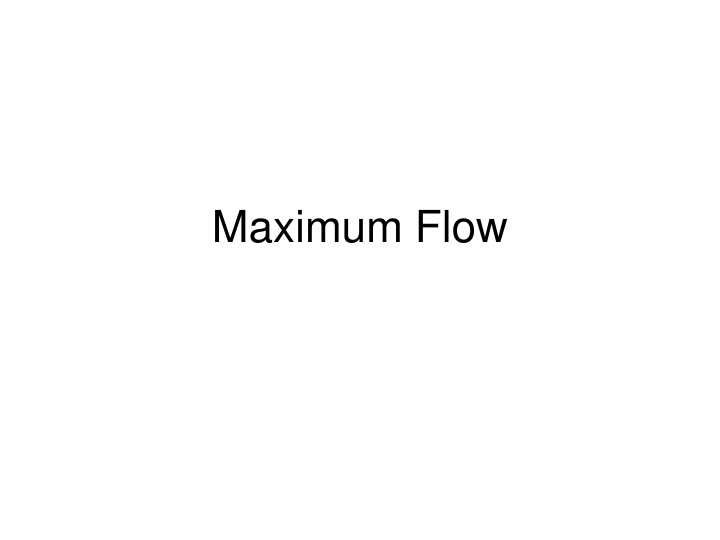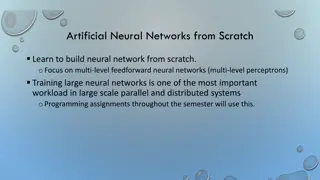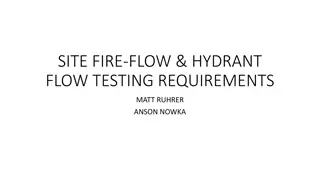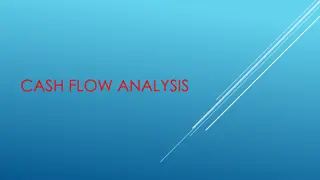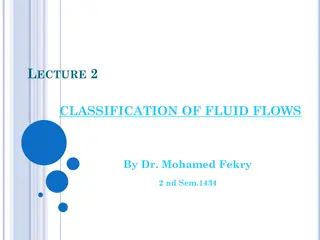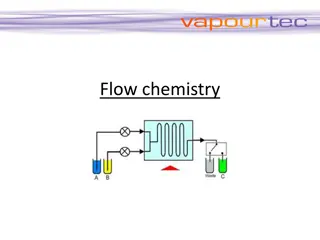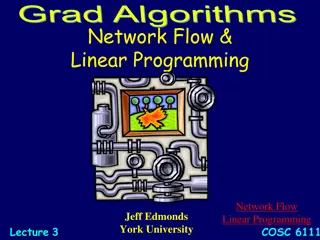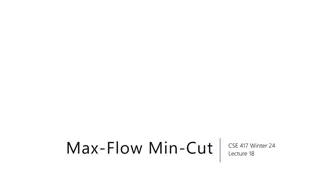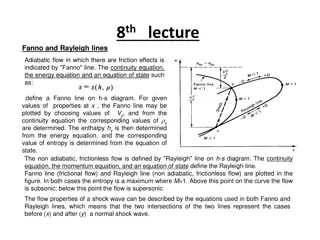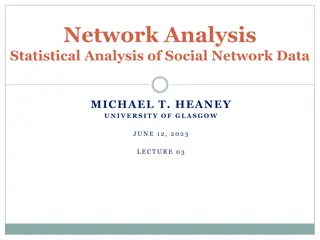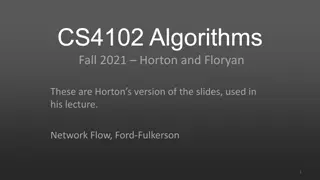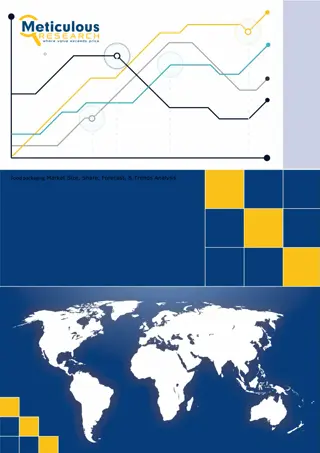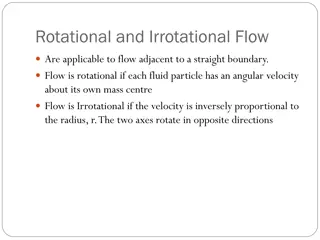Maximum Flow Networks
The concept of maximum flow in network theory, where material flows through a network with specified capacities. Learn about flow conservation, flow concepts, formal max flow problems, cancellation of flows, and finding maximum flow values.
Uploaded on Mar 10, 2025 | 0 Views
Download Presentation

Please find below an Image/Link to download the presentation.
The content on the website is provided AS IS for your information and personal use only. It may not be sold, licensed, or shared on other websites without obtaining consent from the author.If you encounter any issues during the download, it is possible that the publisher has removed the file from their server.
You are allowed to download the files provided on this website for personal or commercial use, subject to the condition that they are used lawfully. All files are the property of their respective owners.
The content on the website is provided AS IS for your information and personal use only. It may not be sold, licensed, or shared on other websites without obtaining consent from the author.
E N D
Presentation Transcript
Flow Graph A common scenario is to use a graph to represent a flow network and use it to answer questions about material flows Flow is the rate that material moves through the network Each directed edge is a conduit for the material with some stated capacity Vertices are connection points but do not collect material Flow into a vertex must equal the flow leaving the vertex, flow conservation
Sample Networks Network Nodes Arcs Flow telephone exchanges, computers, satellites cables, fiber optics, microwave relays voice, video, packets communication gates, registers, processors circuits wires current mechanical joints rods, beams, springs heat, energy reservoirs, pumping stations, lakes pipelines fluid, oil hydraulic financial stocks, companies transactions money freight, vehicles, passengers airports, rail yards, street intersections highways, railbeds, airway routes transportation chemical sites bonds energy
Flow Concepts Source vertex s where material is produced Sink vertex t where material is consumed For all other vertices what goes in must go out Flow conservation Goal: determine maximum rate of material flow from source to sink
Formal Max Flow Problem Graph G=(V,E) a flow network Directed, each edge has capacityc(u,v) 0 Two special vertices: sources, and sinkt For any other vertex v, there is a path s v t Flow a function f : V V R Capacity constraint: For all u, v V: f(u,v) c(u,v) Skew symmetry: For all u, v V: f(u,v) = f(v,u) Flow conservation: For all u V {s, t}: = = ( , ) f u v ( , ) f u V , or 0 a 2/15 v V 4/19 = = ( , ) f v u ( , ) f V u 0 t s 2/5 0/9 v V 3/3 5/14 b
Cancellation of flows We would like to avoid two positive flows in opposite directions between the same pair of vertices Such flows cancel (maybe partially) each other due to skew symmetry a a 2/15 5/19 2/15 5/19 t t s s 0/9 5/5 2/9 3/5 2/3 2/3 5/14 5/14 b b
Max Flow We want to find a flow of maximum value from the source to the sink Denoted by |f| Max Flow, |f| = 19 Or is it? Best we can do? Lucky Puck Distribution Network
Ford-Fulkerson method Contains several algorithms: Residual networks Augmenting paths Find a path p from s to t (augmenting path), such that there is some value x > 0, and for each edge (u,v) in p we can add x units of flow f(u,v) + x c(u,v) Augmenting Path? 8/13 a b 10/15 13/19 10 t s 5/5 9 2/4 6/14 8/11 3/3 c d
Residual Network To find augmenting path we can find any path in the residual network: Residual capacities: cf(u,v) = c(u,v) f(u,v) i.e. the actual capacity minus the net flow from u to v Net flow may be negative Residual network: Gf =(V,Ef), where Ef = {(u,v) V V : cf(u,v) > 0} Observation edges in Ef are either edges in E or their reversals: |Ef| 2|E| 5/15 10 Residual Sub-Graph Sub-graph With c(u,v) and f(u,v) a b a b 5/6 1 c c 0/14 19 5
Residual Graph Compute the residual graph of the graph with the following flow: 8/13 10/15 a b 13/19 10 t s 5/5 9 2/4 6/14 8/11 3/3 c d
Residual Capacity and Augmenting Path Finding an Augmenting Path Find a path from s to t in the residual graph The residual capacity of a path p in Gf: cf(p) = min{cf(u,v): (u,v) is in p} i.e. find the minimum capacity along p Doing augmentation: for all (u,v) in p, we just add this cf(p) to f(u,v) (and subtract it from f(v,u)) Resulting flow is a valid flow with a larger value.
The Ford-Fulkerson method Ford-Fulkerson(G,s,t) 1 for each edge (u,v) in G.E do 2 f(u,v) f(v,u) 0 3 while there exists a path p from s to t in residual network Gfdo 4 cf = min{cf(u,v): (u,v) is in p} 5 for each edge (u,v) in p do 6 f(u,v) f(u,v) + cf 7 f(v,u) -f(u,v) 8 return f The algorithms based on this method differ in how they choose p in step 3. If chosen poorly the algorithm might not terminate.
Execution of Ford-Fulkerson (1) Left Side = Residual Graph Right Side = Augmented Flow
Execution of Ford-Fulkerson (2) Left Side = Residual Graph Right Side = Augmented Flow
Worst Case Running Time Assuming integer flow Each augmentation increases the value of the flow by some positive amount. Augmentation can be done in O(E). Total worst-case running time O(E|f*|), where f* is the max-flow found by the algorithm. Example of worst case: Augmenting path of 1 Resulting Residual Network Resulting Residual Network
Edmonds Karp Take shortest path (in terms of number of edges) as an augmenting path Edmonds-Karp algorithm How do we find such a shortest path? Running time O(VE2), because the number of augmentations is O(VE) Skipping the proof here Even better method: push-relabel, O(V2E) runtime
Multiple Sources or Sinks What if you have a problem with more than one source and more than one sink? Modify the graph to create a single supersource and supersink 13 a b 13 15 13 a b 15 13 10 k i 10 5 t 9 4 s 5 9 4 14 11 3 c 14 11 3 d c d t s 4 4 13 e f 13 15 13 e f 15 13 10 l j 10 5 y 9 4 x 5 9 4 14 11 3 g 14 11 3 h g h
Application Bipartite Matching Example given a community with n men and m women Assume we have a way to determine which couples (man/woman) are compatible for marriage E.g. (Joe, Susan) or (Fred, Susan) but not (Frank, Susan) Problem: Maximize the number of marriages No polygamy allowed Can solve this problem by creating a flow network out of a bipartite graph
Bipartite Graph A bipartite graph is an undirected graph G=(V,E) in which V can be partitioned into two sets V1 and V2 such that (u,v) E implies either u V1 and v V12 or vice versa. That is, all edges go between the two sets V1 and V2 and not within V1 and V2.
Model for Matching Problem Men on leftmost set, women on rightmost set, edges if they are compatible A A A X X X B B B Y Y Y C C C Z Z Z D D D Men Women Optimal matching A matching
Solution Using Max Flow Add a supersouce, supersink, make each undirected edge directed with a flow of 1 A A X X B B t Y s Y C C Z Z D D Since the input is 1, flow conservation prevents multiple matchings
